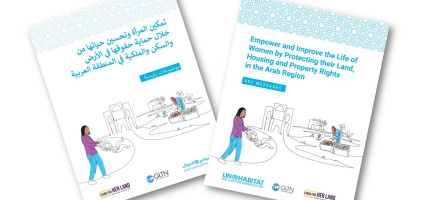Yemen
The country counts over 33 million inhabitants, 61 per cent of which live in rural areas. It has a total land area of 527,970 km2. [1] Yemen's territory includes over 200 islands, including the Hanish Islands, Kamaran group, and Perim, located in the Red Sea, and Socotra, located in the Arabian Sea. Though predominantly rural, Yemen has been experiencing rapid urbanization fuelled by high population growth and rapid rural-to-urban migration. The largest proportion of Yemen’s population is in the agricultural regions and key urban agglomerations. [2]
Yemen has long been the poorest country in the Middle East and North Africa region and it is now in the midst of one of the world’s worst humanitarian crises. Embroiled in conflict since early 2015, fighting has devastated its economy, leading to severe food insecurity and destroying critical infrastructure. [3]
High levels of poverty have manifested themselves through the declined socio-economic situation, high unemployment, low education attainment, poor infrastructure as well as the scarcity of water resources, especially among children, youth, and women. [2]
The COVID‑19 pandemic has created a unique challenge for Yemen, a country where less than half of health facilities is fully functional. Multiple shocks over the last two years, including rising prices, food insecurity, floods, the COVID-19 pandemic, a cholera epidemic, and a locust invasion, have exacerbated pre-existing vulnerabilities for Yemeni households. [3] The deterioration of the security and political situation has also been accompanied by a worsening displacement crisis. [3] Currently, 26.1 million people (80 percent of the population) are in need of humanitarian assistance [4]
The impact of the conflict in Yemen is mainly urban. Half of the Yemeni population lives in areas directly affected by conflict. Even though key cities have faced different levels of destruction, secondary and tertiary cities have become ports for “reverse” population movement transforming them into hosting areas for IDPs. This influx is putting additional strain on existing services and infrastructure that are already scarce or depleted. The crisis resulted in the almost total collapse of basic services and institutions. [2] Additionally, governance, social services, land, housing, property, economies and the environment have been affected. [5]
Land is a root cause and key driver of the conflict in Yemen. Land scarcity and the use of land holdings to gain power by tribal elites in the north, and land reforms to restructure the governance of land and resources, including expropriation of land to create state-run farms in the south, has provided the backdrop for further contention and conflict, also after the unification. [6] With the establishment of the Republic of Yemen in 1990, the push to integrate the two economies and two legal systems included new decrees and investment regulations. [7] In the aftermath of the civil war in 1994, re-organization of land ownership and redistribution of properties in the defeated south was carried out. Through this process, state land was returned both to legitimate previous owners and other people claiming to be “rightful owners” by different ministries. In some cases, the same land was allotted to multiple people who had been loyal supporters of the Sana’a government, including state employees, army officers, and civil servants. [7] The resulting land grievances from this process continue to fuel the conflict to date.
Legal and institutional framework
In Yemen, a complex legal system of customary and statutory laws, as well as Islamic Law subject to varying interpretations, governs land rights. Almost 90 per cent of land ownership is informal or lacks any legally recognized tenure. [8] The statutory law of Yemen relating to land consists of a few articles in the Constitution, the real property provisions of the Civil Code, and several laws which expand upon the provisions of the Civil Code regarding particular land matters. [9]
There are several laws directly or indirectly related to urban planning, within the different parts of this legislation there are contradictions in the roles and responsibilities of governmental bodies in upholding the planning procedures or land administration. Urban planning and management activities are amongst others carried out under the Urban Planning Law No. 20 of 1995, the Executive Regulations for Urban Planning Ministerial Resolution No. 260 of 1997, the Local Authority Law No. 4 of 2000, in addition to other laws related to planning. The Urban Planning Law delegates most planning responsibilities, including implementation, to local administrations. The executive regulations of the Law were introduced in 1997 and focus on the standards of master plans and redistricting of land plots based on proposed plans, as well as the establishment of committees linked to residential or land complexes.
In 1995, Yemen passed Land and Real Estate Law No. 21 of 1995. The law provides for the classification of land (public, private, communal) and the terms of use. However, the land and real estate law generally governs urban land, while land governance in rural areas follows customary and Islamic law under the leadership of sheikhs. The Waqf Law No. 23 of 1992, governs land donated to religious organizations, including the terms for leasing waqf lands.
In 2006, the State Land and Real Estate Authority was replaced by the General Authority for Land Survey and Urban Planning which became responsible for the comprehensive management and administration of land in Yemen. It has consolidated authority over several functions formerly exercised by different entities, including (i) land survey, mapping, and registration; (ii) management of state land and real estate; and (iii) urban planning.
In May 2010, a draft National Land Policy was finalized, and five policy studies were proposed; (i) Land Registration, (ii) Information Technology and Computerized Land Information System, (iii) Land Tenure and Access to Land, (iv) Public Land Inventory, and (v) Institutional Responsibilities. In 2012, the draft policy was submitted to the Government for revision but is yet to be formalised. [5]
Land tenure
Yemeni law, both statutory and Shari‘a, recognizes certain fundamental form of land tenure. The land tenure system is composed of tenures, each of which has its own legal definition and distinctive rules. These are state land, private ownership, religious endowments (waqf/awqaf lands), communal ownership, and tenancy. Land without ownership automatically becomes state property. Property rights under Yemeni law are expressed both in custom and statute and are informed by the Shari‘a (Islamic law), which provides the basic property categories for land in Yemen. [9]
Key statutory enactments are the Civil Code and the Law on State Lands and Real Estate, but there are other important land laws, such as laws intended to mitigate the impact of the reversal of land reform in former South Yemen, a law regulating the notarial profession and law on land registration. [9]
The property continues to be broadly owned among rural households. Land rights are usually supported by documents, though not often registered in rural areas. Tenure security, as reflected by long average terms of parcel possession, seems to be reasonably strong. [9]
State land is regulated through the Law on State Lands and Real Estate (No. 21 of 1995) that supplements the provisions of state land in the Constitution and the Civil Code, providing a more detailed treatment of the matter. This law makes the State Lands and Real Estate Authority responsible for the management of state lands and buildings. [9]
Private land is the most common form of land tenure. Privately-owned land is governed by the Shari‘a and customary law and it is generally documented by a written deed or contract, usually signed by a religious authority or a shaykh who is in charge of updating records (e.g., to show inheritance). The ways in which ownership can be established under the Code are purchase, grant, inheritance, taking up land that has no owner, a revival of abandoned land, and pre-emption. The law concerning private ownership of land is satisfactory in most respects, and ownership and land transactions are well understood by the public. The Shari‘a-based right of pre-emption limits security in land transactions, but also provides a mechanism that allows families and neighbours to retain land that might be bought by outsiders without interfering too directly with the land market. [9]
Religious endowments are an important form of tenure throughout the Islamic world. Waqf originates in privately owned land which has been placed in trust under Shari‘a law. Waqfs land, given their perpetuity, constitutes a form of collective and inalienable property holdings by families or communities. Both categories of waqf provide important opportunities to the land-poor in Yemen, since they are often cultivated by tenants, and the wafq institution has generally been seen as mitigating land concentration. [9]
Communal land rights in Yemen are unclear, unlike most Islamic countries where they are recognized as 'urf, or custom. While Yemeni law includes provisions on co-ownership of land, they do not appear to deal with co-ownership of privately owned land and have little relevance to customary communal land. This is an important gap in Yemeni land law. There is also the category of communal or "tribal" land, which is not clearly defined under legislation. It is primarily land considered marginal, which is often used for grazing or other activities. Such land is administered pursuant to customary norms. Under customary norms, construction in such areas requires the consent of the community. [9]
Tenancies are an important means of access to land in Yemen, especially for the poor, and their relatively stable terms under customary rules have historically provided a reasonable degree of tenure security. Customary rules, however, are increasingly being challenged under increased pressure on land, and landlords are taking advantage of their stronger bargaining power. [9]
Land Value
There is growing competition for land in Yemen. This is driven in some parts of the country by the development of new water technologies which have enabled larger-scale cultivation and created economic opportunities. Access to water directly impacts land values and access to land that cannot be ignored in any study of land rights and needed reforms. Land values are rising rapidly. This is resulting in some forced sales of private land and questionable appropriations of state and communal land by private interests. [9]
The cost of land in the cities is increasing, with high demand for urban land. This has affected access to safe, affordable, and adequate housing and added stress to already vulnerable families. This is further exacerbated by significant supply-side constraints to housing and land markets escalating construction costs. [5]
Land and property transactions are taxed with 3.0 per cent of the sales value, due when the new owner registers the plot. [5] A contribution of 2.5 per cent of the profit through added value is further expected from the seller. [5]
Mobilization of state land and waqf land resources to more effectively provide land access to the poor could play a critical role. An adequate response will require the development of a purpose-driven agenda that recognizes as priorities in this transitional period both limiting the growth of landlessness and providing new avenues to access land for the landless poor. [9]
Land use
Since 1990, land use is an issue over which there is general confusion in the literature on Yemen, specifically, variations in land use and how they affect the introduction of change in the agricultural sector. Data on the use of agricultural land in the Yemen is available, but it is contradictory on several points, with major differences in estimates of the country's cultivated area. [10]
Current land use in Yemen reflects very closely the environment, while management practices have evolved to mitigate the harshness of the environment and to maximize the returns from the land at the time of conserving resources. It should be noted that Yemen's land use map has not yet been produced. [11]
It is estimated that state-owned lands form 90 per cent of all lands in Yemen. [12] Public land includes desert, non-valorised land (Arady Mowat in Arabic) including undeveloped/uncultivated land, mountains and slopes, unpopulated islands and beaches, plots without identifiable owners or heirs, some 70 per cent of the so-called marahek – the dry riverbeds, [12] as well as land locally considered to be owned communally. [13] State land is rented to tenant farmers with similar arrangements to tenancies on other lands. The remaining 10 per cent of non-state land included 5-9 per cent of agricultural and cultivated land, and 1-2 per cent of urbanized land. Updated data on classification (e.g. urban, agricultural, uncultivated, desert, etc.) and ownership of land is missing. [5]
State-owned lands are classified by the law according to the following categories: (i) state developable lands (Arady Mokhassassa in Arabic ), which are defined as "lands that have been planned or prepared and serviced in view of distribution," i.e. the urban expansion zones; (ii) agricultural lands and uncultivated agricultural lands (Arady Bour in Arabic); (iii) desert lands (without planned land uses); (iv) islands and beaches; and (v) marahek (which, as stipulated in the law, are part of the State‘s public domain in the "main cities").
Under Law No. 35 (2006), which stipulate its establishment, the General Authority for Land, Survey and Urban Planning was mandated with research, studies and surveying on land use, preparation and analysis of topographic maps and aerial photography, and identifying and mapping informal housing. [5]
Land development
The rapid urban growth observed in Yemeni cities over the past decades has expanded into both state-owned and private land. In the main highland cities, land available for urban expansion has been privately owned, with more than half of the urbanised land estimated to be an uncontrolled and un-regulated informal land subdivision. [12] In coastal towns, urban growth has mainly unfolded on the state-land. The fast urban expansion in the absence of appropriate planning and regulation instruments has resulted in the rapid increase of informal land development and housing construction without building permits, or connections to infrastructure or municipal services. In the coastal towns, with the preferential distribution of state lands in the past, there is now a scarcity of land suitable for planned urban growth, including planning for affordable housing.
Land expropriation: Article 20 in the Yemeni Constitution protects citizens from the general expropriation of their assets. Public Eminent Domain Law (1995) gives governmental bodies, including governors, the right to acquire private property for projects in the public interest. Yemeni law stresses that land expropriation is to take place only if there is no suitable land in the public domain and fair compensation is made. Article 59 in the State’s Lands and Real Estates Law also recognizes the rights of squatters on public domain to receive compensation in the event of involuntary settlement. Compensation is determined by standards set by the technical committees of the Ministry of Public Works and the General Authority for Land Survey and Urban Planning. [14]
Land dispute resolution
In Yemen, the most common land disputes can be categorised into the following seven types: overlapping claims; boundary disputes; disputes over inheritance and divorces; informal occupation; disputes over temporary housing arrangements; water disputes; and firewood disputes. [15]
Land dispute resolution in urban areas relies primarily on the court's system (primary courts). However, solving disputes in the courts is hampered by slow court processes, high costs, and a system subject to corruption. In rural settings, dispute resolution is reliant on customary practice and Islamic Law, and mediation from district and village officials and local tribe leaders. In some cases, in the absence of functioning legal institutions to address land disputes and grievances and limited access to customary and religious dispute resolution mechanisms, urban dwellers do not have any legal recourse. This is particularly critical for internally displaced people and others who face evictions or those facing seizure of their properties. Today, the government is rarely able to protect private property. [16]
Land disputes in Yemen are increased and deepen by the absence of a transparent land registry and of a system for authenticating land deeds and documents (formal or customary), a weak cadastre, complex and overlapping legal systems for land and tenure, a history of land grabbing, and lack of adequate dispute settlement mechanisms. Land and water disputes constituted 50-85 per cent of all cases appearing before primary courts in 2011. [15]
The ambiguity around ownership and land rights is further amplified by cases where legit land titles are deemed invalid against petitions from claimants with better connections and/or more power. Transgression of traditional rights is increasingly common. Moreover, the nature of land ownership and distribution issues is such that law enforcement and judicial powers are subject to political, social, and economic influence, putting weaker social groups at a disadvantage. [5]
Key interventions
Through support of the European Union, UN-Habitat has developed urban profiles in eight cities in Yemen. The city profiles reflect on the context of Yemen which is suffering from protracted armed conflict since 2015. The profiling feeds into UN-Habitat’s Urban Recovery Framework, and it includes an analysis of the damage assessment and effect of war on the political, social, and economic conditions.
Based on detailed assessments and analysis, UN-Habitat Yemen Programme is focusing on supporting the most vulnerable and affected population with both emergency interventions and durable solutions in the form of damaged housing rehabilitation and community WASH infrastructure facilities and systems. Given the huge influx of internally displace people to urban settings in search for a safe heaven, as well as families returning to their homes, they oftentimes lose their housing, land and property documentation. Since 2021, UN-Habitat is implementing an initiative focusing on awareness, legal counseling, alternative dispute resolution (through mediation), and mapping of housing, land and property claims to support the rights of vulnerable communities and improve land tenure security for women.
References
[1] The World Bank (2023). Data: Yemen.
[2] UN-Habitat (2022). Yemen: Overview.
[3] The World Bank (2022). The World Bank In Yemen:
[4] OCHA (2022). Humanitarian Needs Overview 2023. Yemen.
[5] UN-Habitat and the European Union (2020). State of Yemeni Cities 2020.
[6] ECFR (2019). Mapping the Yemen Conflict. Accessed: July 09, 2022.
[7] Anne-linda Amira Augustin (2015). Spaces in the Making: Peripheralization and Spatial Injustice in Southern Yemen. Focus. Middle East Topics & Arguments 05.
[8] UN-Habitat (2016). Habitat III Regional Report; Arab Region.
[10] Varisco, D. (1990). Land Use and Agricultural Development in the Yemen Arab Republic.
[11] AREA/FAO (2002). Characterization Review of Rain-fed areas in Yemen.
[13] Paul Prettitore (2007). Yemen Rural Land Rights Review (Draft) (np, np). In Shamshad Akhtar et al., “Republic of Yemen Land Tenure for Social and Economic Inclusion in Yemen: Issues and Opportunities,” December 01, 2009.
[15] NRC (2019). Repairing Fractured Landscapes: Challenges and Opportunities for Resolving Disputes over Land, Housing, Water and Other Natural Resources in Yemen.
UN-Habitat, Yemen :
Disclaimer
The information contained in this page is based on the body of knowledge developed by UN-Habitat, GLTN and the Arab Land Initiative’s partners. The designations employed and the presentation of the material do not imply the expression of any opinion whatsoever on the part of the Secretariat of the United Nations concerning the legal status of any country, territory, city or area, or of its authorities, or concerning delimitation of its frontiers or boundaries, or regarding its economic system or degree of development. The information may contain inaccuracies due to the data source(s) and do not necessarily reflect the views of UN-Habitat or its governing bodies.
The Yemen page is still under construction. Share with us any relevant information, resource or correction to enrich our library. Contact the Arab Land Initiative at unhabitat-arablandinitiative@un.org !












